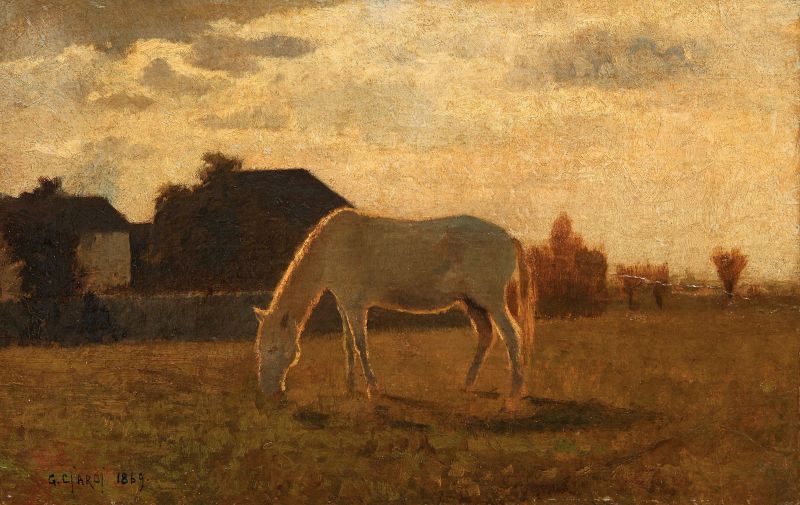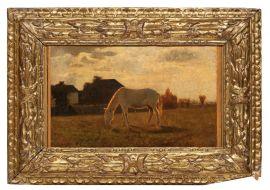Guglielmo Ciardi
(Venezia 1842 - 1917)
CAVALLO BIANCO
1869
firmato e datato “1869” in basso a sinistra
olio su tela
cm 23,4x35,8
sul retro: timbro del Comm. Gerardo Celestini sul telaio
WHITE HORSE
1869
signed and dated “1869” lower left
oil on canvas
9 3/16 by 14 1/16 in
on the reverse: stamp of the Comm. Gerardo Celestini on the stretcher
Bibliografia
Guglielmo Ciardi. Catalogo generale dei dipinti, a cura di N. Stringa, Crocetta del Montello (TV) 2007, p. 283, tav. 342.
Fin da studente Guglielmo Ciardi era attratto dalla pittura dal vero, arricchita dalla luminosità di quella macchiaiola e napoletana, conosciuta durante un viaggio lungo l'Italia Centro-Meridionale effettuato nel 1868. Al rientro a Venezia, oltre alle prime importanti vedute lagunari, caratterizzate da splendidi e ampi scorci in cui cieli grandiosi, caratterizzati da grumi di nubi, si riflettono nell'acqua segnata dal passaggio di piccole imbarcazioni, l'artista inizia a dedicarsi a dipinti ambientati nella campagna trevigiana. Affascinato dagli sbalzi cromatici presenti nell'entroterra veneto, vi raffigura la vita dei contadini, i campi e le cascine animati da cavalli e somarelli visti in solitudine o impegnati a trainare carri di fieno. Tra questi soggetti c'è anche un cavallo bianco, ritratto più volte e sempre dal lato sinistro, mentre si rinfresca nello stagno o passeggia nel campo pianeggiante. In questa versione, compiuta nel 1869, l'animale è visto in controluce in un gioco di cromie che mette in risalto il pelo chiaro del cavallo in un contorno aureo. Sullo sfondo, nella zona di sinistra, un cascinale e alcuni alberi scuri fanno da contrasto a un cielo luminoso, mosso da grandi nuvole chiare. Una variante simile a questo dipinto si trovava nella collezione di Enrico Piceni e proveniva dagli eredi di Zandomeneghi.
Ever since his student days, Guglielmo Ciardi was fascinated by paintings from life, with the rich luminosity of the Macchiaiolo and Neapolitan schools that he encountered during a trip through Central-Southern Italy in 1868. When he returned to Venice, in addition to his early important views – vedute – of the lagoon with splendid skies and scattered clumps of clouds reflected in the waters dotted with small boats, the artist began working on paintings set in the Treviso countryside. Intrigued by the amazing colours of the Veneto region’s hinterland, he depicted farmers, fields and houses, enlivening his pictures with horses and donkeys either alone in fields or pulling carts of hay. One of his subjects was a white horse that he painted more than once, either taking a dip in a pond or walking in the field, but always viewed from the left. In this painting, done in 1869, the horse is seen against the light, in a play of colours that highlights his white coat in what can almost be described as a golden halo. In the back, to the left is a farmhouse and some dark trees that contrast with a luminous, cloud-filled sky. There was a similar painting to this one that Federico Zandomeneghi’s heirs had given to Enrico Piceni for his collection.






